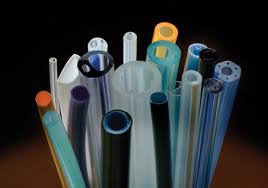Termoplastics
A thermoplastic is a type of plastic made from polymer resins that becomes a homogenized liquid when heated and hard when cooled. When frozen, however, a thermoplastic becomes glass-like and subject to fracture. These characteristics, which lend the material its name, are reversible. That is, it can be reheated, reshaped, and frozen repeatedly. This quality also makes thermoplastics recyclable.
There are dozens of kinds of thermoplastics, with each type varying in crystalline organization and density. Some types that are commonly produced today are polypropylene, polyethylene, polyvinylchloride, polystyrene, polyethylenetheraphthalate and polycarbonate.

- History
- Properties
- Applications
- Processes
- Recycling
- Faq
History
Celluloid, which is considered the first thermoplastic, made its appearance in themid-1800s and reigned in the industry for approximately 100 years.
During its peak production, it was used as a substitute for ivory. Today, it is used to make guitar picks.
Since that time, different thermoplastic types made their entry (see: types of plastics).
Properties
Thermoplastics are defined as polymers that can be melted and recast for different use almost indefinitely.
Thermoplastics have the simplest molecular structure, with chemically independent macromolecules.
- By heating, they are softened or melted, then shaped, formed , welded, and solidified when cooled.
- Multiple cycles of heating and cooling can be repeated without severe damage, allowing reprocessing and recycling.
Applications
Thermoplastics have been around for a long time and are an important component of everyday life today.
For example, acrylonitrile butadiene styrene (ABS) is a type of thermoplastic used to manufacture:
- sports equipment
- toys (i.e., LEGO® blocks)
- various automobile parts
Polycarbonate is used to make
- compact discs (CDs)
- drinking bottles
- food storage containers
- eyeglass lenses, among other things.
Polyethylene is likely the most commonly encountered thermoplastic and is used to make
- shampoo bottles
- plastic grocery bags
- and even bullet proof vests
Processes
The most basic component that is used to produce thermoplastics is the monomer building blocks. For example, propylene monomer is used to produce polypropylene, ethylene to produce polystyrene, vinylchloride to produce polyvinylchloride, etc ...
Today the raw material used to produce thermoplastics is mostly derived from fossil feedstock. Biobased feedstocks are also making their inroads.
Recycling
Thermoplastics can be recycled as you can remelt and reshape them.
Energy can also be recovered from used thermoplastics.
